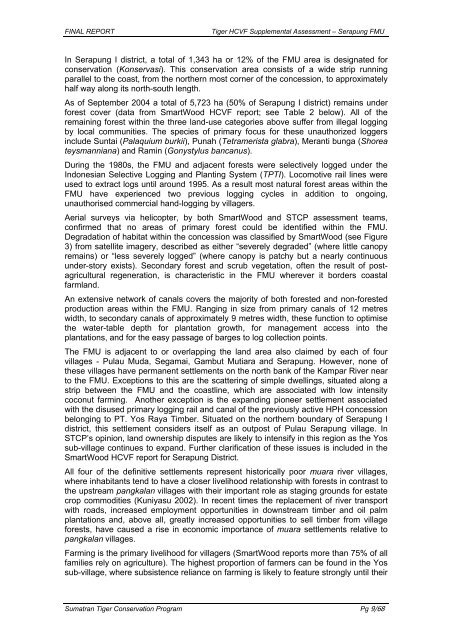A Supplemental HCVF Assessment on the Sumatran Tiger ...
A Supplemental HCVF Assessment on the Sumatran Tiger ...
A Supplemental HCVF Assessment on the Sumatran Tiger ...
Create successful ePaper yourself
Turn your PDF publications into a flip-book with our unique Google optimized e-Paper software.
FINAL REPORT <strong>Tiger</strong> <str<strong>on</strong>g>HCVF</str<strong>on</strong>g> <str<strong>on</strong>g>Supplemental</str<strong>on</strong>g> <str<strong>on</strong>g>Assessment</str<strong>on</strong>g> – Serapung FMU<br />
In Serapung I district, a total of 1,343 ha or 12% of <strong>the</strong> FMU area is designated for<br />
c<strong>on</strong>servati<strong>on</strong> (K<strong>on</strong>servasi). This c<strong>on</strong>servati<strong>on</strong> area c<strong>on</strong>sists of a wide strip running<br />
parallel to <strong>the</strong> coast, from <strong>the</strong> nor<strong>the</strong>rn most corner of <strong>the</strong> c<strong>on</strong>cessi<strong>on</strong>, to approximately<br />
half way al<strong>on</strong>g its north-south length.<br />
As of September 2004 a total of 5,723 ha (50% of Serapung I district) remains under<br />
forest cover (data from SmartWood <str<strong>on</strong>g>HCVF</str<strong>on</strong>g> report; see Table 2 below). All of <strong>the</strong><br />
remaining forest within <strong>the</strong> three land-use categories above suffer from illegal logging<br />
by local communities. The species of primary focus for <strong>the</strong>se unauthorized loggers<br />
include Suntai (Palaquium burkii), Punah (Tetramerista glabra), Meranti bunga (Shorea<br />
teysmanniana) and Ramin (G<strong>on</strong>ystylus bancanus).<br />
During <strong>the</strong> 1980s, <strong>the</strong> FMU and adjacent forests were selectively logged under <strong>the</strong><br />
Ind<strong>on</strong>esian Selective Logging and Planting System (TPTI). Locomotive rail lines were<br />
used to extract logs until around 1995. As a result most natural forest areas within <strong>the</strong><br />
FMU have experienced two previous logging cycles in additi<strong>on</strong> to <strong>on</strong>going,<br />
unauthorised commercial hand-logging by villagers.<br />
Aerial surveys via helicopter, by both SmartWood and STCP assessment teams,<br />
c<strong>on</strong>firmed that no areas of primary forest could be identified within <strong>the</strong> FMU.<br />
Degradati<strong>on</strong> of habitat within <strong>the</strong> c<strong>on</strong>cessi<strong>on</strong> was classified by SmartWood (see Figure<br />
3) from satellite imagery, described as ei<strong>the</strong>r “severely degraded” (where little canopy<br />
remains) or “less severely logged” (where canopy is patchy but a nearly c<strong>on</strong>tinuous<br />
under-story exists). Sec<strong>on</strong>dary forest and scrub vegetati<strong>on</strong>, often <strong>the</strong> result of postagricultural<br />
regenerati<strong>on</strong>, is characteristic in <strong>the</strong> FMU wherever it borders coastal<br />
farmland.<br />
An extensive network of canals covers <strong>the</strong> majority of both forested and n<strong>on</strong>-forested<br />
producti<strong>on</strong> areas within <strong>the</strong> FMU. Ranging in size from primary canals of 12 metres<br />
width, to sec<strong>on</strong>dary canals of approximately 9 metres width, <strong>the</strong>se functi<strong>on</strong> to optimise<br />
<strong>the</strong> water-table depth for plantati<strong>on</strong> growth, for management access into <strong>the</strong><br />
plantati<strong>on</strong>s, and for <strong>the</strong> easy passage of barges to log collecti<strong>on</strong> points.<br />
The FMU is adjacent to or overlapping <strong>the</strong> land area also claimed by each of four<br />
villages - Pulau Muda, Segamai, Gambut Mutiara and Serapung. However, n<strong>on</strong>e of<br />
<strong>the</strong>se villages have permanent settlements <strong>on</strong> <strong>the</strong> north bank of <strong>the</strong> Kampar River near<br />
to <strong>the</strong> FMU. Excepti<strong>on</strong>s to this are <strong>the</strong> scattering of simple dwellings, situated al<strong>on</strong>g a<br />
strip between <strong>the</strong> FMU and <strong>the</strong> coastline, which are associated with low intensity<br />
coc<strong>on</strong>ut farming. Ano<strong>the</strong>r excepti<strong>on</strong> is <strong>the</strong> expanding pi<strong>on</strong>eer settlement associated<br />
with <strong>the</strong> disused primary logging rail and canal of <strong>the</strong> previously active HPH c<strong>on</strong>cessi<strong>on</strong><br />
bel<strong>on</strong>ging to PT. Yos Raya Timber. Situated <strong>on</strong> <strong>the</strong> nor<strong>the</strong>rn boundary of Serapung I<br />
district, this settlement c<strong>on</strong>siders itself as an outpost of Pulau Serapung village. In<br />
STCP’s opini<strong>on</strong>, land ownership disputes are likely to intensify in this regi<strong>on</strong> as <strong>the</strong> Yos<br />
sub-village c<strong>on</strong>tinues to expand. Fur<strong>the</strong>r clarificati<strong>on</strong> of <strong>the</strong>se issues is included in <strong>the</strong><br />
SmartWood <str<strong>on</strong>g>HCVF</str<strong>on</strong>g> report for Serapung District.<br />
All four of <strong>the</strong> definitive settlements represent historically poor muara river villages,<br />
where inhabitants tend to have a closer livelihood relati<strong>on</strong>ship with forests in c<strong>on</strong>trast to<br />
<strong>the</strong> upstream pangkalan villages with <strong>the</strong>ir important role as staging grounds for estate<br />
crop commodities (Kuniyasu 2002). In recent times <strong>the</strong> replacement of river transport<br />
with roads, increased employment opportunities in downstream timber and oil palm<br />
plantati<strong>on</strong>s and, above all, greatly increased opportunities to sell timber from village<br />
forests, have caused a rise in ec<strong>on</strong>omic importance of muara settlements relative to<br />
pangkalan villages.<br />
Farming is <strong>the</strong> primary livelihood for villagers (SmartWood reports more than 75% of all<br />
families rely <strong>on</strong> agriculture). The highest proporti<strong>on</strong> of farmers can be found in <strong>the</strong> Yos<br />
sub-village, where subsistence reliance <strong>on</strong> farming is likely to feature str<strong>on</strong>gly until <strong>the</strong>ir<br />
<strong>Sumatran</strong> <strong>Tiger</strong> C<strong>on</strong>servati<strong>on</strong> Program Pg 9/68

















